Australian Private Credit Poised for Expansion: Brian Ho Unveils Key Drivers at Singapore Symposium
Brian Ho, Associate Director at Aura Private Credit, shared insights on the burgeoning potential of Australian private credit markets during his...
Small and Medium Enterprises (SMEs) have long been neglected by the banking sector in Australia.

Small and Medium Enterprises (SMEs) have long been neglected by the banking sector in Australia.
The amount of data required to assess the credit, application processing time and associated costs of processing has meant that the banks have pushed SMEs towards real estate-backed loans. This does not suit SMEs in many cases. Given the increased complexity of the credit assessment, many SME loans have higher yields than consumer loans.
In this wire, I explain how this has created a funding gap that SME Alternative Finance (AltFi) lenders are seeking to bridge in order to set the context for the emergence of SME debt capital as an emerging asset class for investors seeking income and returns that have little to no correlation with public markets.
AltFi lenders have developed products that allow SMEs to borrow to match the duration of their funding needs, on an unsecured basis or secured against non-real estates business assets such as invoices or stock. Technology, in particular cloud accounting software and online access to bank account information, has enabled significantly faster credit assessments and reduced funding times for SMEs, opening up an underbanked market within the SME sector. The market opportunity is significant for Fintech-enabled SME AltFi lenders.
The main impediment to growth for Fintech-enabled AltFi lenders is access to funds to lend to SME borrowers. Banks have proven reluctant to fund these Fintech businesses in recent years potentially due to their relatively short track record or ethical considerations due to perceived higher rates being charged by these lenders.
Small business is typically defined as companies that employ 5–19 staff and medium-sized business are defined as companies that employ 20–199 staff. As of 30 June 2019, there were 212,247 small businesses and 56,835 medium-sized businesses.
Moreover, as of 30 June 2019, businesses with fewer than 200 employees accounted for 66 per cent of employment.
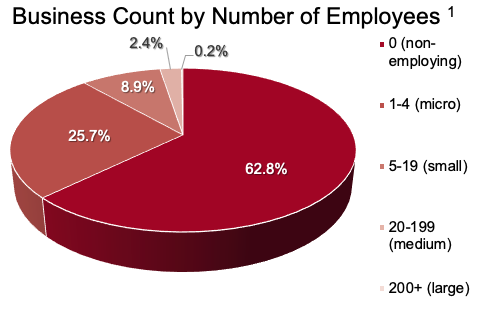
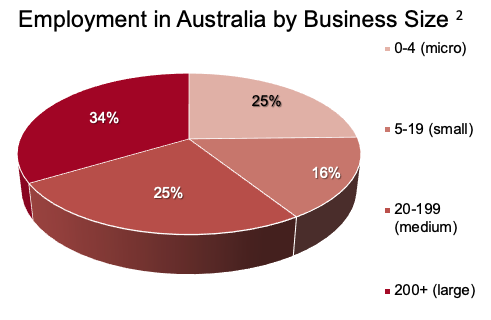
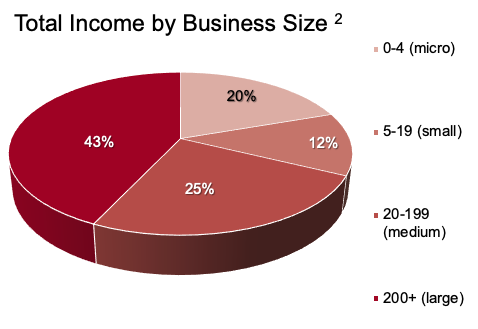
SMEs also account for a significant proportion of private sector income. As at 30 June 2019, private sector income totalled $3.7 trillion, of which small businesses (5-19 employees) accounted for $462 billion and medium businesses (20 – 199 employees) $919 billion (2)
Small business entrepreneurs will often use their families’ finances to fund their businesses. Some seek external funding, which can include extra equity or debt from family and friends, debt from financial institutions or equity from venture capital funds. In Australia, the banks’ business models and expertise may be more suited to providing debt finance to established businesses whereas venture capital is more suited to start-up firms in nascent industries.
Whilst SMEs in Australia continue to make a significant contribution to the economy, they have not been well supported by the banking sector. The main friction points SMEs suffer within the banking sector include:
Bank requirements for owners of SMEs to post significant personal collateral for the business lend;
Time required for the application process with the bank to be finalised and approved;
The time lag between loan application and loan funding; and
Products not always matching the borrowing needs of the SME e.g. the duration of the loan may not match the SME's borrowing requirements where the bank requires the loan to be held for a minimum term with penalties imposed for early repayment.
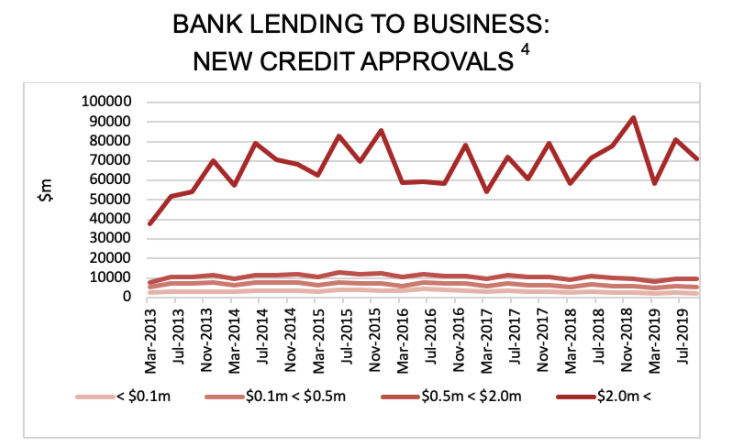
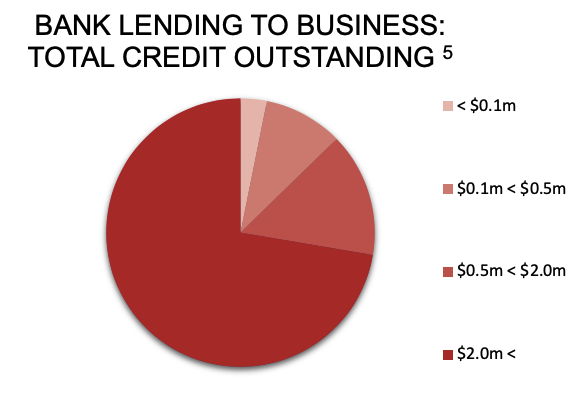
Banks have been unable to efficiently process the smaller end of the SME credit space as their current processes take time due to the manual nature of information collection and processing. This has led to SMEs seeking out alternative sources to fund their growth.
Total bank lending to business new credit approvals, which represents new loans approved, for the year ended September 2019 for loans under $2 million, amounted to AUD $67.540 billion, down 10.88% and AUD $8.249 billion on the previous 12-month period. Meanwhile, loans over $2 million amounted to AUD $302.835 billion, up 5.59% and AUD $16.032 billion in the previous 12-month period.
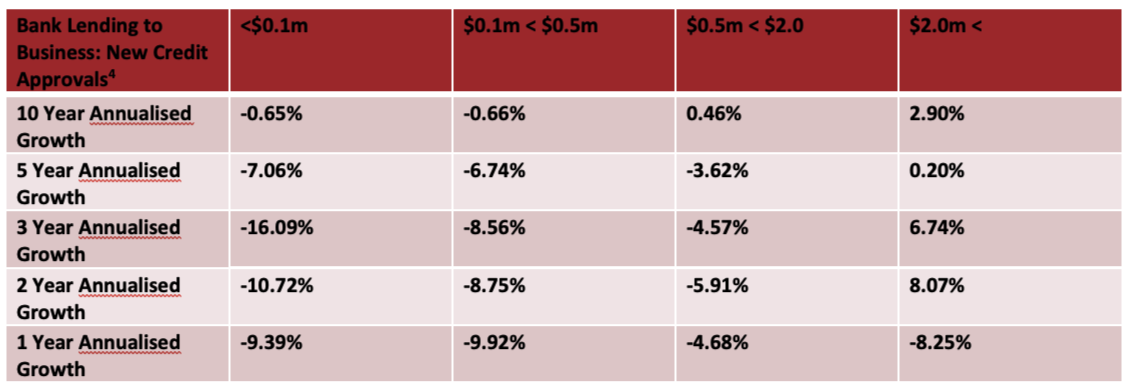
SME Alternative Finance (AltFi) lenders have been set up to target the underbanked markets within the Australian business landscape to provide financing solutions to Australian SMEs.
The underbanked market includes businesses that have passed on potential growth opportunities due to difficulty in receiving finance, although not necessarily due to poor credit, but potentially due to its lack of size, or where, from the business perspective, there is a lack of human resources to complete the application process.
Some lenders in the AltFi SME sector use technology applications to collect data from borrowers and monitor the financial health of the business on an ongoing basis, whilst the loan is still live. This allows the lender to have an insight into the ability of the counterparty to repay the loan on an ongoing basis. A further extension to this is the ability to work with the borrower on their forward cash flow projections and tailor funding solutions to the business.
Lenders may use application programming interfaces (APIs) to plug into cloud-based accounting software and bank accounts to share data and reduce much of the friction in the application process, saving time for the borrower and making borrowing funds a less manual and much smoother process.
According to the Australian Banking Association Economic Report, September 2019, “Australian Banking Association data shows a 33 per cent decline in (SME) business loan approvals over the past five years, while approval rates remain around 94%”.
Given approval, rates have remained relatively steady over the past five years, the 33 per cent decline in loan approvals can only be explained by a reduction in loan applications made by SMEs. This data in combination with ABS Counts of Australian Businesses data, which shows a 6.96 per cent increase in the number of Australian SMEs over the five-year period to June 30 2019, suggests the reduction in applications is not due to an off-setting decline in the number of SMEs. Rather, the data suggest SMEs are looking elsewhere for their funding requirements.
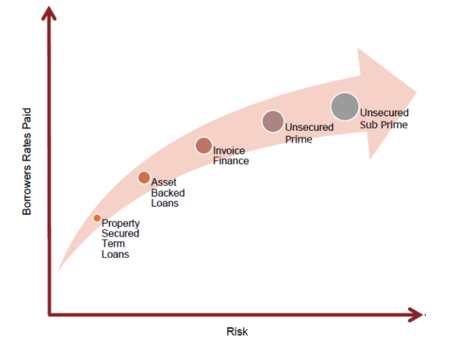
Lenders in the SME AltFi sector will predominately apply risk-based pricing to their product set. Risk-based pricing is simply pricing according to the risk of the lender, so a higher rate for a higher risk borrower, and a lower rate for a lower risk borrower. This pricing methodology is not used in the bank models, where rates are offered at each product type.
Loans made by SME AltFi lenders are typically structured as either asset-backed or unsecured, as explained below.
Invoice Finance: Originators in the invoice finance space will lend to an SME as either an advance on the value of an invoice where the invoice is used as collateral or will purchase the invoices from the SME and run credit risk against the organisation of the invoice is issued against.
Secured Term Loans: This segment is a bank-like loan where the lender will require specific assets (most commonly property or business assets) as collateral against the funds being lent. The differentiating factors between a Fintech lender and a bank are the ease of application and a risk-based pricing benefit.
Prime Loans in the prime unsecured market are loans that are made to high-quality borrowers or those that are most creditworthy and are not secured by any assets. These loans have the lowest probability of default in the unsecured segment, thus the rates are generally the lowest in the unsecured space. The borrower will benefit from a clean credit record.
Near Prime: Near prime unsecured loans are a rung down from prime loans. The borrower may have had repayment issues in the past or a higher deemed risk due to a lack of credit history.
Sub-Prime: Sub-prime unsecured loans are made to those borrowers who may have had difficulty maintaining a repayment schedule. These are the highest-risk SMEs in the unsecured market segment and the risk is reflected in the highest rates charged in the market.
The Australian SME AltFi market continues to grow in terms of volumes lent, as SMEs preference for non-banks to fund growth has now surpassed traditional banks. Whilst the banks focus on larger lends, Aura expects this sector to continue to grow. SMEs are actively utilising the greater choice in the funding landscape to support their growth, which is a positive for the wider Australian economy, and the 66% of the workforce that is employed by Australian SMEs.
While SMEs awareness and use of these lending products and lenders have significantly increased in recent years, the primary constraint for the industry is funding for the lenders.
Find out more on Aura High Yield SME Fund.
Important information
This information is for accredited, qualified, institutional, wholesale or sophisticated investors only and is provided by Aura Group and related entities and is only for information and general news purposes. It does not constitute an offer or invitation of any sort in any jurisdiction. Moreover, the information in this document will not affect Aura Group’s investment strategy for any funds in any way. The information and opinions in this document have been derived from or reached from sources believed in good faith to be reliable but have not been independently verified. Aura Group makes no guarantee, representation or warranty, express or implied, and accepts no responsibility or liability for the accuracy or completeness of this information. No reliance should be placed on any assumptions, forecasts, projections, estimates or prospects contained within this document. You should not construe any such information or any material, as legal, tax, investment, financial, or other advice. This information is intended for distribution only in those jurisdictions and to those persons where and to whom it may be lawfully distributed. All information is of a general nature and does not address the personal circumstances of any particular individual or entity. The views and opinions expressed in this material are those of the author as of the date indicated and any such views are subject to change at any time based upon market or other conditions. The information may contain certain statements deemed to be forward-looking statements, including statements that address results or developments that Aura expects or anticipates may occur in the future. Any such statements are not guarantees of any future performance and actual results or developments may differ materially from those projected in the forward-looking statements. This information is for the use of only those persons to whom it is given. If you are not the intended recipient, you must not disclose, redistribute or use the information in any way.
Aura Group subsidiaries issuing this information include Aura Group (Singapore) Pte Ltd (Registration No. 201537140R) which is regulated by the Monetary Authority of Singapore as a holder of a Capital Markets Services Licence, and Aura Capital Pty Ltd (ACN 143 700 887) Australian Financial Services Licence 366230 holder in Australia. View Privacy Policy here
Brian Ho, Associate Director at Aura Private Credit, shared insights on the burgeoning potential of Australian private credit markets during his...
ASIC’s latest private credit reviews outline higher expectations for transparency, governance, valuation, liquidity and credit-risk management as the...
So, is DeepSeek just another AI model, or does it offer something truly different?
Subscribe to News & Insights to stay up to date with all things Aura Group.